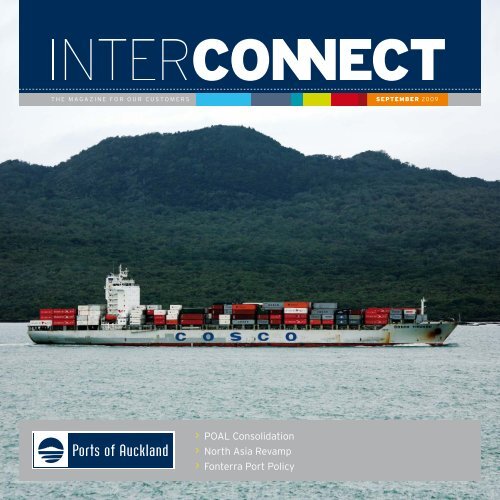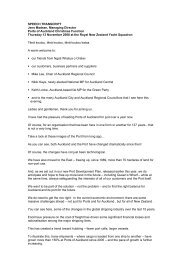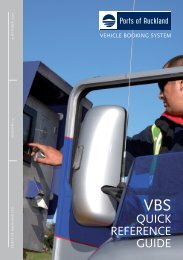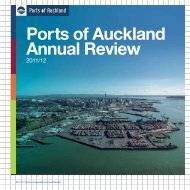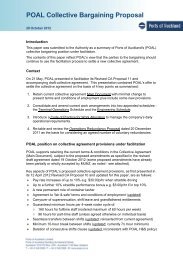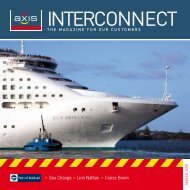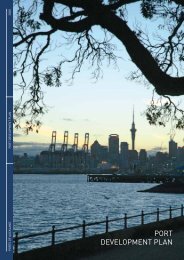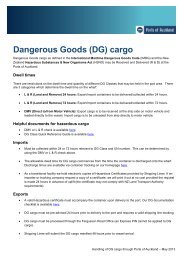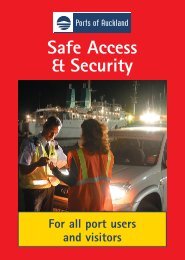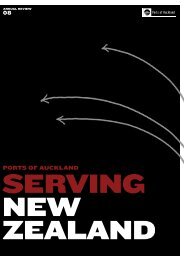Download publication - Ports of Auckland
Download publication - Ports of Auckland
Download publication - Ports of Auckland
Create successful ePaper yourself
Turn your PDF publications into a flip-book with our unique Google optimized e-Paper software.
T H E M A G A Z I N E F O R O U R C U S T O M E R S SEPTember 20 0 9<br />
> POAL Consolidation<br />
> North Asia Revamp<br />
> Fonterra Port Policy
CONTENTS<br />
2-3<br />
POAL<br />
FOCUS<br />
4-5<br />
OPERATIONS<br />
REVIEW<br />
Streamlining<br />
truck flow<br />
X-Ray scan moves<br />
8-9<br />
FACE<br />
TO FACE<br />
Cargo Co-ordinators<br />
& the NAPA service<br />
14-15<br />
MARKET<br />
ROUND UP<br />
6-7<br />
NEW SERVICE REPORT<br />
Strong North Asia combination<br />
10-11<br />
POAL<br />
NEWS<br />
12-13<br />
FONTERRA<br />
chooses <strong>Auckland</strong> in<br />
new direct-load port<br />
policy<br />
BACK<br />
PAGE<br />
DIRECTORY<br />
POAL<br />
FOCUS<br />
GRANT JOREY<br />
GENERAL<br />
MANAGER AXIS<br />
OPERATIONS &<br />
PRODUCTIVITY<br />
PORTS OF<br />
AUCKLAND<br />
The last two months<br />
have been pleasing<br />
ones for <strong>Ports</strong> <strong>of</strong><br />
<strong>Auckland</strong>. Highlights<br />
have included the<br />
consolidation <strong>of</strong> our<br />
container operations<br />
at the newly<br />
expanded Fergusson<br />
terminal, and the<br />
settlement <strong>of</strong> our<br />
Collective Employment<br />
Agreement with the<br />
Maritime Union <strong>of</strong><br />
New Zealand.
The consolidation <strong>of</strong> container operations<br />
at Fergusson is the most significant<br />
operational change at the port in at least<br />
a decade, and the result <strong>of</strong> many months<br />
<strong>of</strong> preparation and study into different<br />
options and optimal port configurations.<br />
Our overall objective is to run the most<br />
efficient port we can, while retaining the<br />
flexibility to cater for periods <strong>of</strong> peak<br />
demand, and the ability to cater for future<br />
growth in trade volumes.<br />
We believe that by running a single<br />
stevedoring workforce at Fergusson which<br />
becomes our operations hub, we will get<br />
the best out <strong>of</strong> our land, equipment, berths<br />
and labour.<br />
Through the elimination <strong>of</strong> duplicated<br />
overheads and infrastructure, the recent<br />
changes are already delivering significant<br />
cost savings. Most importantly, we have<br />
more flexibility in allocating our workforce<br />
to meet customer demand.<br />
Bledisloe Wharf has retained its three<br />
container cranes and continues to be<br />
used intensively for port operations,<br />
including containers, non-containerised<br />
cargo and Customs activities. Furthermore,<br />
when Queens Wharf transfers out <strong>of</strong><br />
port ownership in April 2010, the cargo<br />
currently handled on it will transfer to<br />
Bledisloe.<br />
With consolidation in place and the<br />
Collective Employment Agreement<br />
settled, we are also moving ahead with<br />
a range <strong>of</strong> new productivity measures.<br />
These initiatives include new ‘Sattel’<br />
technology to improve straddle driver<br />
performance and plant maintenance and<br />
planned changes to address service delays<br />
associated with shift changeovers.<br />
Overall we’re very satisfied with how the<br />
implementation <strong>of</strong> consolidation has gone.<br />
It feels like a ‘new world’ here and the<br />
buy-in from employees to the single team<br />
concept has been great to see.<br />
There have been some teething problems<br />
and, while truck-turn times are averaging<br />
less than 30 minutes, some significant<br />
delays have been experienced from time<br />
to time. We are taking the delays seriously<br />
and a range <strong>of</strong> measures (see Pgs 4 & 5<br />
Operations Review) has been put in place<br />
to assist road carriers while we work to<br />
address the underlying issues.<br />
I’d like to thank our customers for<br />
their cooperation and input into the<br />
change process. Your suggestions and<br />
feedback have been extremely useful<br />
and valuable.<br />
The <strong>Ports</strong> <strong>of</strong> <strong>Auckland</strong> is<br />
New Zealand’s largest<br />
container port by volume,<br />
handling around 840,000 TEU<br />
(20ft-equivalent units), more<br />
than 1,600 ship calls and 2.7<br />
Million tonnes <strong>of</strong> break-bulk<br />
(non-containerised) cargo<br />
per annum.<br />
POAL SELLS<br />
QUEENS WHARF<br />
The sale <strong>of</strong> Queens Wharf<br />
to the NZ Government<br />
and <strong>Auckland</strong> Regional<br />
Council for NZ$40M will<br />
enable the development<br />
<strong>of</strong> a new cruise ship<br />
terminal. Queens Wharf<br />
will become the primary<br />
cruise terminal, however<br />
Princes Wharf will continue<br />
to operate.<br />
In the meantime the<br />
Government has agreed<br />
that Queens Wharf will<br />
be opened up for public<br />
festivities during the 2011<br />
Rugby World Cup which NZ<br />
is hosting.<br />
POAL Managing Director Jens<br />
Madsen says the Company has been<br />
working on the sale <strong>of</strong> Queens Wharf<br />
for a number <strong>of</strong> years. “We are a<br />
willing seller <strong>of</strong> Queens Wharf and<br />
very pleased to have reached an<br />
agreement.” He said the port will use<br />
proceeds from the sale to reinvest in<br />
replacement cargo handling facilities<br />
and capacity. He confirmed that cargo<br />
volumes currently handled at Queens<br />
Wharf will be transferred to Bledisloe,<br />
Captain Cook and Marsden Wharves<br />
and he reassured customers that<br />
POAL is well prepared for the sale and<br />
that planning is already underway<br />
for the alternative accommodation<br />
<strong>of</strong> cargo business that will move <strong>of</strong>f<br />
Queens Wharf by April 2010.<br />
03
OPERATIONS<br />
REVIEW:<br />
FINE-TUNING<br />
TRUCK FLOW<br />
Following the consolidation<br />
<strong>of</strong> container operations at the<br />
recently expanded Fergusson<br />
Container Terminal, <strong>Ports</strong> <strong>of</strong><br />
<strong>Auckland</strong> is expanding and<br />
reconfiguring its Fergusson<br />
truck processing infrastructure<br />
to cater for the additional<br />
traffic that will be handled<br />
there. POAL Operations &<br />
Productivity Manager Grant<br />
Jorey says the recent expansion<br />
<strong>of</strong> the terminal has brought<br />
an additional 6.4 ha <strong>of</strong> space.<br />
“This gives us the ability<br />
to reconfigure and expand<br />
our truck parking area and<br />
processing grid including the<br />
installation <strong>of</strong> additional lanes<br />
and self-service kiosks.”<br />
He acknowledged that during the early<br />
stage <strong>of</strong> the terminal consolidation<br />
process, road carriers at the port had<br />
experienced delays. He said the Port<br />
Company has been working closely with<br />
the road transport community to address<br />
the delays. “Over the last month <strong>of</strong><br />
August 76% <strong>of</strong> all shifts have recorded<br />
average truck processing times <strong>of</strong><br />
30 minutes or less. We are committed to<br />
returning truck processing times to<br />
Australasia best standard <strong>of</strong> below<br />
30 minutes as soon as possible.”<br />
Towards that end a number <strong>of</strong> new<br />
measures are being implemented.<br />
They include:<br />
• Increasing the ratio <strong>of</strong> straddle<br />
carriers to the number <strong>of</strong><br />
Vehicle Booking System (VBS)<br />
slots.<br />
• Altering Bledisloe receival<br />
and delivery hours to better<br />
match demand.<br />
• Working collaboratively with<br />
the road transport industry to<br />
reduce VBS ‘no shows’.<br />
• Improvements to the Fergusson<br />
truck park to aid traffic flow and<br />
improve safety.<br />
• Separate resourcing for the<br />
loading and unloading <strong>of</strong> <strong>Ports</strong><br />
<strong>of</strong> <strong>Auckland</strong> shuttle trucks (an<br />
activity that was previously<br />
resourced from the truck<br />
receival and delivery resources).<br />
• Implementation <strong>of</strong> a new<br />
forecasting tool that will enable<br />
us to better predict demand for<br />
road-side receival and delivery<br />
<strong>of</strong> containers.<br />
Following a Road Transport Forum meeting<br />
in August with POAL to discuss these<br />
issues, Simon Tapper, Director <strong>of</strong> major<br />
NZ transport company Tapper Transport,<br />
said he was heartened to learn that several<br />
concrete steps were planned to remedy<br />
the situation imminently. “Ideally it will suit<br />
the container transport operators to carry<br />
all containers through one portal to the<br />
<strong>Auckland</strong> waterfront.”<br />
CUSTOMS X-RAY SCANNER MOVES<br />
TO BLEDISLOE<br />
As part <strong>of</strong> <strong>Ports</strong> <strong>of</strong> <strong>Auckland</strong>’s recent terminal<br />
reorganisation, the NZ Customs X-Ray facility<br />
has moved from Fergusson Container Terminal<br />
to Bledisloe Wharf where access is via the<br />
Tinley Street Gate.<br />
One <strong>of</strong> three New Zealand Customs (NZC)<br />
scanning vehicles employed at NZ’s border<br />
control centres, the NZC unit is equipped to<br />
carry out full and empty container scans.<br />
The relocation has released additional space<br />
at the Fergusson Truck Park to accommodate<br />
increased volume arising from the terminal<br />
reorganisation. Under the recently<br />
consolidated Fergusson Terminal operation,<br />
container transport operators are required to<br />
carry the majority <strong>of</strong> containers through the<br />
single portal <strong>of</strong> Fergusson Container Terminal<br />
rather than dividing loads between Bledisloe<br />
and Fergusson.<br />
With additional space released in the<br />
Fergusson Truck Park, POAL’s General<br />
Manager Operations & Productivity, Grant<br />
Jorey, says further changes underway at<br />
the Fergusson Truck Park are all designed to<br />
enhance truck flow and safety.<br />
There is also a change in the X-Ray Shuttle<br />
billing and payment procedure. (See POAL<br />
News Pgs 10 & 11).<br />
Empty Depot<br />
<strong>Ports</strong> <strong>of</strong> <strong>Auckland</strong>’s Empty Container Depot is<br />
now under the management <strong>of</strong> POAL service<br />
partner United Containers Ltd (UCL). The<br />
Empty Depot remains in the same location at<br />
Bledisloe Wharf where UCL has taken over the<br />
management and running <strong>of</strong> the Depot from<br />
POAL. UCL is now responsible for receival and<br />
delivery <strong>of</strong> empties and is providing a range <strong>of</strong><br />
empty container services.
“Ideally it will suit the container<br />
transport operators to carry all<br />
containers through one portal to<br />
the <strong>Auckland</strong> waterfront.”<br />
05
NEW<br />
SERVICE<br />
REPORT:<br />
STRONG<br />
COMBINATION<br />
FOR NORTH ASIA<br />
In this year <strong>of</strong> rationalisations,<br />
two formerly competitive alliances<br />
operating the NZ/North Asia trade,<br />
have got together to make one new,<br />
refined service out <strong>of</strong> the ANZL<br />
consortium <strong>of</strong> Hamburg Sud,<br />
Hapag-Lloyd and TOL and the<br />
ICS/COSCo grouping <strong>of</strong> Maersk, MOL,<br />
NYK and COSCo.<br />
In this newly consolidated service, the<br />
partners are COSCo, Hamburg Sud, MOL and<br />
NYK with Maersk and Hapag-Lloyd as slot<br />
charterers. TOL, a former member <strong>of</strong> the<br />
ANZL group is no longer participating in the<br />
consortium. The weekly service deploys six<br />
2,800 – 3,500 TEU vessels – two each from<br />
COSCo and Hamburg Sud and one each from<br />
MOL and NYK. To accommodate the high<br />
demand for reefer cargo on the northbound<br />
NZ/North East Asia (NEA) trade, all six vessels<br />
have 500 reefer plugs. For <strong>Ports</strong> <strong>of</strong> <strong>Auckland</strong>,<br />
while COSCo, MOL and NYK are long term<br />
major customers, the rationalisation sees the<br />
welcome return <strong>of</strong> Hamburg Sud and Hapag-<br />
Lloyd to <strong>Auckland</strong> for their North Asia service<br />
which previously under the former ANZL<br />
brand, went through Tauranga.
With <strong>Auckland</strong> selected as first NZ port<br />
call, the revised service calls six other NZ<br />
ports and on then to Tokyo, Kobe, Busan,<br />
Shanghai, Yantian, Hong Kong and Brisbane.<br />
All the partner lines confirm that in the<br />
current economic downturn, a reduction in<br />
NZ import volumes was a major driver for<br />
this rationalisation. They have therefore<br />
been agreeably surprised to find their<br />
anticipated 1,000 TEU per exchange,<br />
outweighed to the tune <strong>of</strong> 1,600 TEU<br />
up to 1,900 TEU per exchange since<br />
the revised service started. All this is<br />
making for busy exchanges at POAL: “The<br />
inbound service has received much higher<br />
support than any <strong>of</strong> us anticipated which<br />
is great. We believe a contributing factor<br />
to be shippers’ preference for direct, fast<br />
access to the major industrial heartland<br />
that POAL provides’ says Richard Potton,<br />
POAL Manager Sales Marketing & Product<br />
Development.<br />
Inevitably the combination <strong>of</strong> the two<br />
services has demanded compromises.<br />
The ICS/COSCo consortium lost its Port<br />
Otago call; Hamburg Sud brought a New<br />
Plymouth call into the rotation and operates<br />
an exclusive call to and from Brisbane.<br />
ICS/COSCo lost its final NZ export call at<br />
<strong>Auckland</strong> with Tauranga winning final call.<br />
Originally a one ship contributor to the<br />
service, Maersk’s vessel was pulled leaving<br />
Maersk as slot charterer.<br />
The combined service reflects a reduction in<br />
overall capacity yet all carriers seem content<br />
with the new balance and allocations. “For<br />
COSCo it means a bit less capacity but the<br />
new capacity combination has evened out<br />
the space availability, making it much more<br />
flexible and easier to work with for our<br />
customers on a weekly basis ” observes<br />
Mark Scott, COSCo General Manager NZ.<br />
From older tonnage in the former ICS/COSCo<br />
consortium, modern vessels introduced by<br />
NYK and MOL, modern vessels have brought<br />
the desired increase in available 40ft<br />
container capacity. For Ge<strong>of</strong>f Davy, NYK NZ<br />
Associate Director, the benefits <strong>of</strong> the new<br />
service include a more uniform allocation <strong>of</strong><br />
space and the removal <strong>of</strong> 40ft restrictions<br />
which enables greater flexibility <strong>of</strong> cargo<br />
mix. “We’ve been operating this service since<br />
1976 since which time it’s been developed<br />
and adjusted to market requirements. This<br />
then is another step in the evolution <strong>of</strong> the<br />
former NZ/Japan service. The combined<br />
service well suits current demand with<br />
direct and fast transits to the Japanese and<br />
North Asia export markets plus expanded<br />
coverage <strong>of</strong> mainland China where we are<br />
experiencing growth for both exports and<br />
imports”.<br />
At MOL, NZ General Manager Malcolm<br />
Woods comments that the new VSA is very<br />
‘strong’: “It’s brought stability to the service<br />
and enabled us all to move forward. There<br />
have been the inevitable teething problems<br />
but the service is bedding down well. Imports<br />
are picking up, dry exports are buoyant and<br />
now we are working towards peak season.”<br />
With NZ’s peak perishable export season<br />
running January through May, the<br />
Consortium is presently evaluating the best<br />
options for an extra-loader programme to run<br />
adjacent to the current enhanced system. It<br />
seems likely that Hamburg Sud will provide<br />
the additional vessels with the support <strong>of</strong><br />
consortium partners to ensure that all peak<br />
season reefer trade volumes are adequately<br />
accommodated.<br />
Hamburg Sud NZ General Manager, Simon<br />
Edwards, says such a programme would<br />
be designed to accommodate peak season<br />
exports including squash, apples, onions,<br />
dairy and meat on top <strong>of</strong> the regular market<br />
demand. “An extra loader programme would<br />
complement the regular weekly product with<br />
an additional two or three vessels to serve the<br />
important North East Asian reefer markets”.<br />
The withdrawal <strong>of</strong> its vessel from the service<br />
in which it now slot charters is ‘suiting’ Maersk<br />
according to NZ Country Manager, Julian<br />
Bevis. “There have been so many service<br />
changes around the world in response to<br />
deteriorating market conditions. We now have<br />
greater co-operation between lines with more<br />
VSAs and such operating arrangements are<br />
working well for us in the current market.<br />
In this Consortium, we have maintained a<br />
presence in the trade where we continue to<br />
provide a service. Then too, we have our own<br />
SEA service to Tanjung Pelepas with relay<br />
connections to various ports in Asia.”<br />
07
FACE TO FACE WITH:<br />
FACE<br />
TO FACE:<br />
CARGO<br />
CO-ORDINATORS’<br />
POSITIVE<br />
PASSION<br />
In these recessionary times, a<br />
genuinely new shipping service<br />
is a rarity. Not only is Partner<br />
Shipping’s NAPA (North America<br />
Pacific) service new, it is also<br />
pioneering car, truck and<br />
heavylift RoRo links between<br />
West Coast North America<br />
(WCNA), South East Asia and<br />
Australasia on a route that<br />
the Company says has been<br />
‘inadequately’ served until now.<br />
In a statement about its new service<br />
Partner Shipping said: ‘NAPA is<br />
responding to demand in existing and<br />
emerging markets where current<br />
servicing has been inadequate, namely<br />
North America and Asia. In regard to<br />
WCNA, the auto/RoRo market has been<br />
inadequately serviced for many years to<br />
both Asia and Australia/New Zealand.<br />
Partner Shipping is therefore establishing<br />
a triangular service from WCNA through<br />
Singapore to Australia and NZ returning<br />
directly to Mexico and WCNA.’<br />
Calling <strong>Auckland</strong> every 30 days, the<br />
NAPA service rotation is Los Angeles,<br />
Grays Harbour (Washington State),<br />
Singapore, Fremantle, Melbourne, Port<br />
Kembla, Brisbane, <strong>Auckland</strong>, Lazaro<br />
Cardenas, Los Angeles.<br />
A welcome reflection <strong>of</strong> confidence and<br />
positivity, the first vessel in the NAPA<br />
auto/high/heavy service was the<br />
newbuild Silverstone Express. The<br />
3,900 CEU (car equivalent unit) RoRo<br />
made its maiden call to <strong>Ports</strong> <strong>of</strong><br />
<strong>Auckland</strong> in July. Since then it has been<br />
joined by RoRo sistership Positive<br />
Passion. And there’s more to come!<br />
Such is the confidence <strong>of</strong> Partner<br />
Shipping and its associates including<br />
Australian agency Praxis Logistics and<br />
NZ Agent Cargo Co-ordinators, that<br />
three more identical PCTC (Pure Car &<br />
Truck Carrier) specification RoRo<br />
newbuildings are due for delivery late<br />
August and November 2009 and<br />
February 2010. The NAPA service<br />
venture has options for these vessels<br />
as well.<br />
As the NZ agent for Partner Shipping’s<br />
NAPA service, Noel Thompson <strong>of</strong> Cargo<br />
Co-ordinators addressed the issue <strong>of</strong><br />
launching a new service ‘at a time <strong>of</strong><br />
significant economic downturn’: “The<br />
specifications <strong>of</strong> these PCTCs have<br />
substantial capacity for vehicles as well<br />
as giving access to two high and heavy<br />
decks which are ideal for carrying<br />
out-<strong>of</strong>-gauge equipment, machinery,<br />
large trucks and various craft. Until<br />
now this type <strong>of</strong> capacity – and on a RoRo<br />
vessel rather than lift on lift <strong>of</strong>f – has only<br />
been available on transhipment services. The<br />
nature <strong>of</strong> this cargo makes transhipment<br />
undesirable and it is much more securely<br />
loaded and unloaded onto a RoRo rather than<br />
with conventional lift- on-lift-<strong>of</strong>f equipment.”<br />
Despite a downturn in vehicle imports to NZ<br />
over the past year and severe recessionary<br />
effects on the major US car manufacturers,<br />
Noel Thompson is confident NAPA will<br />
achieve its car carrying ambitions. “There are<br />
Right-Hand Drive cars manufactured in the<br />
US. It’s clear that the US car manufacturers<br />
are ironing out their financial wrinkles and<br />
will get sorted – those plants are far too big<br />
to disappear altogether.”<br />
He says that NAPA will also be looking for<br />
export cargo with a focus on the big four NZ<br />
export sectors to the US – timber, MDF, steel<br />
and aluminium. “There’s plenty <strong>of</strong> potential<br />
– the world’s highest quality aluminium is<br />
made at Alcan in Bluff. None <strong>of</strong> that has<br />
moved to the US since Jebsens withdrew<br />
shipping services two years ago. Forestry has<br />
been at a low ebb but things are picking up in<br />
terms <strong>of</strong> new dwelling starts in the US where<br />
there was an 11% increase in July. We’re<br />
positive that demand will increase for export<br />
product in these sectors and we will have our<br />
hand up to carry it.”
Norwegian company Partner Shipping was established in 2008 by<br />
people experienced in deep, short sea shipping and car carrying.<br />
Over the past year the company has spot traded in Europe, the Middle<br />
East and West Africa before launching its first liner service –<br />
NAPA in June 2009.<br />
In July 2009, Partner was joined by 50% shareholder Siem Industries whose<br />
shipping interests include oil & gas servicing and ocean shipping with a<br />
fleet <strong>of</strong> 114 vessels working for Subsea (45%), Siem Offshore (34%), Star<br />
Reefers (72%), Siem Car Carriers (100%).<br />
09
NEWS:<br />
Top Container Port<br />
<strong>Ports</strong> <strong>of</strong><br />
<strong>Auckland</strong> is<br />
the only New<br />
Zealand port<br />
to be included<br />
in Container<br />
Management<br />
Magazine’s 2009<br />
Top Container<br />
<strong>Ports</strong> list.<br />
In this year’s listing POAL retains<br />
its 105th position on the list in<br />
which Singapore, Shanghai and<br />
Hong Kong are rated as the world’s<br />
top container ports.<br />
Other Australasian ports included<br />
in the top container ports list<br />
include Melbourne, Sydney and<br />
Brisbane.<br />
state-<strong>of</strong>the-art<br />
operational &<br />
environmental<br />
design<br />
><br />
NEW TANKER<br />
FOR POAL BUNKERING:<br />
<strong>Ports</strong> <strong>of</strong> <strong>Auckland</strong>’s new fuel tanker arrived in<br />
<strong>Auckland</strong> mid August. Built in Turkey, the 80-metre<br />
tanker with capacity for 25,000 barrels <strong>of</strong> oil will<br />
be based in <strong>Auckland</strong> where it will take over the<br />
provision <strong>of</strong> re-fuelling services for cruise ships<br />
and commercial vessels calling the port.<br />
Named at an <strong>of</strong>ficial ceremony in<br />
<strong>Auckland</strong> in September, the Awanuia<br />
has state-<strong>of</strong>-the-art operational<br />
and environmental design features<br />
including double hull construction,<br />
sophisticated alarm systems and<br />
vapour-venting capacity. It will load<br />
fuel from the Marsden Point refinery<br />
and then pump directly on to ships<br />
at berth at POAL or at anchor <strong>of</strong>f the<br />
port. POAL Managing Director Jens<br />
Madsen, said the new tanker brought<br />
the essential guarantee that <strong>Auckland</strong><br />
can provide a commercial marine fuel<br />
supply for many years to come.<br />
“Offering re-fuelling services in<br />
<strong>Auckland</strong> is vital to retaining and<br />
growing the number <strong>of</strong> calls from<br />
international cargo and cruise ships.”<br />
He said most cruise ships only carry<br />
two weeks supply <strong>of</strong> fuel and so the<br />
ability to access re-fuelling services<br />
in <strong>Auckland</strong> is essential. “The new<br />
service is also good news for vessels<br />
trading in the Pacific Islands as refuelling<br />
in the Pacific can be expensive<br />
and restrictive at times” he said.<br />
Jens Madsen is also the Chairman<br />
<strong>of</strong> Seafuels, a joint venture company<br />
between POAL and Pacific Basin<br />
Shipping, which owns the tanker.<br />
Under time charter to Shell NZ, the<br />
tanker’s day-to-day technical operation will<br />
be managed by PB Sea Tow, part <strong>of</strong> Pacific<br />
Basin Shipping’s towage operation.
INLAND<br />
PORT RAIL<br />
EXCHANGE<br />
Construction <strong>of</strong> the new Rail<br />
Exchange at <strong>Ports</strong> <strong>of</strong> <strong>Auckland</strong>’s<br />
Inland Port at Wiri in South<br />
<strong>Auckland</strong> is progressing well towards<br />
completion by December this year.<br />
Jointly funded by POAL and KiwiRail,<br />
the exchange will connect the<br />
15 ha Wiri Inland Port with the<br />
national rail network and provide<br />
a direct link to <strong>Ports</strong> <strong>of</strong> <strong>Auckland</strong>’s<br />
seaport on the waterfront in<br />
<strong>Auckland</strong> City.<br />
Links between the Wiri Inland Port and the<br />
<strong>Auckland</strong> seaport are currently provided by<br />
road transport. Once fully operational, the rail<br />
link is forecast to eventually save up to 2.5M<br />
truck kilometres per year – the equivalent <strong>of</strong><br />
100,000 truck trips. POAL Managing Director<br />
Jens Madsen says the rail connection will<br />
create a clean, green option for businesses<br />
looking to optimise their supply chain.<br />
“The net effect when containers are<br />
loaded and unloaded <strong>of</strong>f rail wagons will<br />
be to create an effective multi-modal<br />
hub that reduces traffic congestion in<br />
central <strong>Auckland</strong>. One <strong>of</strong> our aims is to<br />
get a better balance <strong>of</strong> full and empty<br />
containers running between Wiri and the<br />
seaport taking waste out <strong>of</strong> the supply<br />
chain and increasing productivity. This<br />
represents an important step for POAL<br />
in our aim to become a ‘super port for a<br />
super city’ serving the greater <strong>Auckland</strong><br />
region and New Zealand. We see a bright<br />
future for Wiri Inland Port as a freight hub<br />
– a staging post that will link the South<br />
<strong>Auckland</strong> industrial and manufacturing<br />
heartland with the Waikato region<br />
and with the port <strong>of</strong> <strong>Auckland</strong> on the<br />
Waitemata harbour.”<br />
Reefer Monitoring<br />
& Power:<br />
The demurrage free period after vessel<br />
discharge, will be billed to the shipping<br />
line concerned. Shipping lines need to<br />
advise their customers that thereafter<br />
the charge will be billed to the importing<br />
party. Where possible the charge will<br />
be billed directly to the importer but if<br />
unknown then it will be passed to the agent<br />
collecting the container.<br />
X-Ray<br />
Shuttle:<br />
NZ Customs X-Ray unit is now based at<br />
Bledisloe Wharf. The charge for the POAL<br />
shuttle transfer <strong>of</strong> the NZ Customs (NZC)<br />
requested box from the container stack<br />
to NZC and back, will now be paid for by<br />
the shipper who will be billed directly by<br />
POAL. On receipt <strong>of</strong> the electronic container<br />
scan demand from NZC, POAL will notify the<br />
shipping line which must provide shipper<br />
details to POAL for it to obtain shipper<br />
acceptance <strong>of</strong> the cost, before the container<br />
can be transferred to X-Ray.<br />
Shipping lines and their customers can see<br />
details <strong>of</strong> the new systems at www.poal.co.nz<br />
and at: www.axis-intermodal.co.nz<br />
CONSULTING WITH<br />
CUSTOMERS<br />
POAL has established a Business User<br />
Reference Group.<br />
Comprising shipping line representatives<br />
and port personnel, this group meets<br />
regularly to discuss Business Rules,<br />
terminal systems, SMS – the ship<br />
management system and related issues.<br />
“Using the Reference Group we are able<br />
to make decisions based on the collective<br />
viewpoint <strong>of</strong> the Group” says Richard<br />
Potton, POAL Manager Sales, Marketing<br />
& Product Development. He explains that<br />
the Reference Group owes its origins to<br />
VBS: “We started this approach when we<br />
were planning the introduction <strong>of</strong> VBS – the<br />
Vehicle Booking System. We got together<br />
with the Road Transport Association<br />
and trucking companies to work through<br />
issues collectively before pushing the final<br />
‘product’ out into the market. And that’s<br />
what this Reference Group is all about.<br />
It’s an excellent forum for us to initiate<br />
a consultative approach with our major<br />
customers.”<br />
INCREASED<br />
SECURITY<br />
Visitors to POAL will notice a big change.<br />
There is no staff-controlled entry point<br />
any longer for those gaining access to<br />
Fergusson Terminal and wharves. The<br />
entire area is now fenced in with access<br />
for all except container transporters, via<br />
security swipe card.<br />
11
AUCKLAND<br />
WINS MORE<br />
FONTERRA<br />
BUSINESS<br />
<strong>Ports</strong> <strong>of</strong> <strong>Auckland</strong> has welcomed the recently announced<br />
decision by Fonterra, New Zealand’s largest exporter, to<br />
consolidate its NZ port usage to focus on services out <strong>of</strong><br />
<strong>Auckland</strong> and three other direct loader ports. In its August<br />
2009 announcement, the Co-operative described this as<br />
part <strong>of</strong> a cost cutting drive towards the achievement <strong>of</strong><br />
greater efficiency in its NZ export supply chain.<br />
NIGEL<br />
JONES<br />
The consolidation reflects renewed Fonterra<br />
focus on the four direct load ports <strong>of</strong><br />
<strong>Auckland</strong>, Tauranga and Napier in the North<br />
Island and Lyttelton in the South. These<br />
four will share a higher volume <strong>of</strong> Fonterra<br />
cargo at the expense <strong>of</strong> the two regional<br />
ports <strong>of</strong> Timaru and New Plymouth which<br />
will lose some 65% and 80% <strong>of</strong> present<br />
Fonterra containerised volume through<br />
their ports (equivalent to some 22,000 and<br />
25,000 boxes a year respectively).<br />
In recent years, Fonterra has tended to use<br />
shipping services to a lesser or greater<br />
extent, out <strong>of</strong> at least 10 <strong>of</strong> NZ’s surfeit<br />
<strong>of</strong> 11 container handling ports. Several <strong>of</strong><br />
the ports used are close to major Fonterra<br />
manufacturing plants including both<br />
Timaru and New Plymouth. Over recent<br />
times export volume out <strong>of</strong> these ports in<br />
particular was being feedered to larger hub<br />
ports such as <strong>Auckland</strong>, for transhipment<br />
onto direct load services.<br />
Fonterra General Manager Supply Chain<br />
Strategy Nigel Jones, identifies key drivers<br />
for the significant change <strong>of</strong> policy as:<br />
• A tightening <strong>of</strong> capacity around NZ.<br />
• Greater transparency <strong>of</strong> the actual cost<br />
associated with servicing regional ports<br />
by indirect services.<br />
• The extra cost being incurred by<br />
the supply chain due to additional<br />
rehandling costs.<br />
• Lack <strong>of</strong> service choice at the two<br />
ports where, for example, Fonterra was<br />
restricted to one carrier and one weekly<br />
service for South East Asia cargo.<br />
• The availability <strong>of</strong> multiple sailing<br />
options and carriers from <strong>Auckland</strong> and<br />
Tauranga.<br />
• Renewed confidence in NZ’s rail<br />
service under the management <strong>of</strong> newly<br />
re-nationalised KiwiRail.<br />
“Basically the approach we are taking<br />
is to focus upon direct export loading<br />
ports. Hence, if cargo would otherwise be<br />
transhipped on the NZ coast we will now<br />
seek to load that cargo out <strong>of</strong> a direct loading<br />
port” said Nigel Jones. Explaining that<br />
efficient access to NZ ports is fundamental<br />
to Fonterra’s supply chain strategy, he said<br />
that the increased use <strong>of</strong> rail and the focus<br />
on direct loader ports will slash the lead time<br />
from packing at site to some destinations, by<br />
over 24%.<br />
Nigel Jones reports that managing space<br />
out <strong>of</strong> NZ ports has become increasingly<br />
challenging ‘given the dramatic reduction<br />
in capacity and with the consolidation <strong>of</strong><br />
services we’ve seen in NZ over the past<br />
18 months’. “As a result, space has been<br />
a lot tighter which reduces our flexibility<br />
and precludes us from managing things as<br />
efficiently as we would like. ”<br />
Although shipping lines may disagree, he<br />
maintains that ‘NZ shippers have not in<br />
recent years enjoyed the significant rate<br />
declines witnessed around the globe’. He<br />
confirmed that not only would the new<br />
system provide Fonterra with access to a<br />
greater variety <strong>of</strong> ocean carriers but that ‘it<br />
will reduce our exposure to potential freight<br />
rate increases’. “This approach and the<br />
flexibility it produces will enable us to far
FONTERRA<br />
FACT FILE:<br />
Fonterra’s Whareroa manufacturing plant beneath Mt Egmont in Hawera, Taranaki has the largest milk<br />
processing capacity <strong>of</strong> any dairy manufacturing plant in NZ. It produces milk powders, cheese and butter.<br />
better manage our allocations and capacity<br />
and to overall reduce the waste <strong>of</strong> ever<br />
increasingly valuable space on ships.”<br />
He said that while there would be an impact<br />
on ports which had less volume, the shipping<br />
lines will still be <strong>of</strong>fered the volume Fonterra<br />
has contracted them to carry.” These<br />
changes are about making the best use <strong>of</strong><br />
shipping services out <strong>of</strong> New Zealand and<br />
the country’s ports – to serve our customers<br />
and ultimately, through efficiencies, put<br />
more money into our farmers’ pockets”.<br />
Nigel Jones said that as a country exporting<br />
95% <strong>of</strong> its dairy production, New Zealand’s<br />
ongoing international competitiveness is<br />
dependent on its ability to connect directly<br />
with the major east-west trade flows to the<br />
large consumption markets in the US and<br />
Europe through Asia.<br />
“In addition to the expected efficiency<br />
gains, we need a flexible supply chain that<br />
supports our strategy <strong>of</strong> providing the very<br />
best service to our customers globally,<br />
enabling us to grow with them. NZ can’t<br />
afford to find itself in a position where we<br />
don’t have a sustainable, cost effective<br />
ocean freight network supported by a highly<br />
efficient domestic transport infrastructure.”<br />
Country Manager for Maersk NZ Julian<br />
Bevis, said Fonterra’s decision and its<br />
reasons were helpful fuel for the debate<br />
about the competitiveness <strong>of</strong> NZ exports<br />
and the thought that has to be given to<br />
the creation <strong>of</strong> a more efficient NZ supply<br />
chain. “These are issues that involve all<br />
parties– shipping lines, ports, rail, road and<br />
government. We must all participate and<br />
contribute to this debate about defining the<br />
country’s export infrastructure needs.”<br />
<strong>Ports</strong> <strong>of</strong> <strong>Auckland</strong> Managing Director Jens<br />
Madsen said Fonterra’s focus on fewer ports<br />
to improve its supply chain efficiency was<br />
good news for POAL. “This supports the<br />
hub and spoke system that will work more<br />
efficiently for NZ exports and imports. At<br />
POAL we have invested heavily and worked<br />
long and hard on the development <strong>of</strong> our<br />
business to secure our position as NZ’s<br />
leading hub port. Our investments and<br />
developments have enabled us to build<br />
on our natural advantages which include<br />
scale, proximity to NZ’s largest market and<br />
the ability to cater for larger ships. POAL<br />
is well positioned to take advantage <strong>of</strong> the<br />
acceleration towards increased hubbing in<br />
NZ and to capture a dominant share <strong>of</strong> the<br />
resulting container business. We are NZ’s<br />
largest container port and the container<br />
trade is the largest part <strong>of</strong> our business.”<br />
Fonterra is the<br />
world’s largest dairy<br />
exporter with annual<br />
revenues <strong>of</strong> some<br />
NZ$17B.<br />
Fonterra is NZ’s<br />
largest exporter and<br />
NZ’s largest shipping<br />
account.<br />
The Dairy Co-operative<br />
exports over 2M<br />
tonnes from NZ<br />
equating to approx<br />
135,000TEU pa.<br />
With increasing<br />
interest in dairy<br />
production plants<br />
outside NZ, Fonterra<br />
also exports high<br />
volumes <strong>of</strong> dairy<br />
product from other<br />
markets eg, North<br />
America to Asia and<br />
South America to Asia.<br />
These other regions<br />
account for the<br />
shipment <strong>of</strong> a further<br />
500,000 tonnes pa.<br />
13
MARKET<br />
ROUND UP:<br />
News and<br />
views on<br />
New<br />
Zealand<br />
shipping<br />
trades<br />
Among recent shipping and related<br />
appointments, John Lindsay is<br />
the new Chairman <strong>of</strong> the Board <strong>of</strong><br />
Directors for <strong>Ports</strong> <strong>of</strong> <strong>Auckland</strong>. He is<br />
also Chairman <strong>of</strong> Holcim (NZ), the NZ<br />
Chamber <strong>of</strong> Commerce & Industry, and<br />
its <strong>Auckland</strong> regional branch. After a<br />
major consolidation at Swire Shipping,<br />
represented in NZ by Quadrant Pacific<br />
Agencies (QPA), former QPA General<br />
Manager, Randy Selvaratnam, has been<br />
appointed Swire Shipping NZ (SSNZ)<br />
General Manager. In this capacity he will<br />
report to Sydney-based Swire International<br />
Agency Network and regional <strong>of</strong>fice’s<br />
General Manager Steve Clark. POAL’s<br />
two inaugural Leadership Programme<br />
graduates have taken up permanent<br />
positions with the company. Julian Clarke<br />
is the new Strategic Capacity Planner<br />
with responsibility for forecasting future<br />
container capacity requirements and<br />
for yard planning. As the new Resource<br />
Allocations Manager, Colin Tasi oversees<br />
the Allocations Team and is responsible<br />
for ensuring the effective and efficient<br />
use <strong>of</strong> the integrated workforce. Following<br />
restructuring <strong>of</strong> five global regions into<br />
three at Hapag-Lloyd, the Line’s former NZ<br />
Sales Director Gary Carter has replaced<br />
Blair Morris as NZ General Manager. Blair<br />
Morris has moved to Singapore to take up<br />
his new position as Hapag- Lloyd’s Asia<br />
Region Sales & Customer Services Senior<br />
Director. Former POAL Chief Executive<br />
Ge<strong>of</strong>f Vazey has become Chairman <strong>of</strong><br />
Northland Port Corporation in which POAL<br />
is a 19.9% shareholder. Two new positions<br />
have been announced at Maritime NZ<br />
after restructuring. Sharyn Forsyth heads<br />
up a new group called Maritime Services<br />
with responsibility for operations and safety<br />
systems; the new role <strong>of</strong> Principal Maritime<br />
Adviser is taken on by John Mansell<br />
who will specialise in qualifications and<br />
operational limits.<br />
Following reorganisation at POAL some well<br />
known, long-standing staff members have left<br />
the Company. They include General Wharves<br />
Manager Jim Howard who leaves after 31<br />
years service with POAL and its predecessor<br />
the <strong>Auckland</strong> Harbour Board. After 51 years<br />
in the shipping industry, 41 years on the<br />
<strong>Auckland</strong> waterfront and 27 years with POAL,<br />
Operations Manager Martin Speller has<br />
also departed the Company. At his farewell he<br />
reflected on the many changes since he joined<br />
the port company when Fergusson Container<br />
Terminal then had one Paceo twin-lift crane<br />
and two straddles and when containerised<br />
reefer was all carried in porthole containers<br />
with their clip-on refrigeration units. He<br />
referred to Farrell Lines and their 1972 reefer<br />
service in which the reefer boxes were stowed<br />
in the hatch which was then frozen down<br />
leading to a few wrong containers getting the<br />
freeze treatment!<br />
In a major re-organisation Swire Shipping<br />
has reviewed its liner service operation,<br />
pulled its two round-the-world services and<br />
shed 200 <strong>of</strong> 550 liner staff worldwide. With<br />
renewed focus on Asia Pacific, Swire’s owner<br />
China Navigation Company has acquired the<br />
remaining 33% stake in NZ-based container<br />
and break-bulk operator, Tasman Orient Line<br />
(TOL) from the Ahrenkiel Group. Ahrenkiel<br />
retains its partnership in Quadrant Pacific, a
NZ ships agency which was set up with TOL in<br />
1999 through a merger between Tasman Asia<br />
Line (TAL) and NZ Orient Line (NZOL) which<br />
was founded in 1989 by Christian Ahrenkiel<br />
who has now withdrawn from direct liner<br />
operations. TOL’s East Asia/NZ trade services<br />
have now been combined with Swire Shipping<br />
services which continue to call <strong>Ports</strong> <strong>of</strong><br />
<strong>Auckland</strong> on the TransTasman and the Pacific<br />
Islands services, the NZ/New Caledonia<br />
service and the Bank Line westabout Roundthe-World<br />
service.<br />
POAL has won a prestigious 2009<br />
Green Ribbon Award from the Ministry<br />
for the Environment. The Award is made<br />
in the Business category for a Company<br />
demonstrating an ongoing commitment<br />
to reducing environmental impacts. In<br />
its submission POA included a recent<br />
major lighting upgrade project and the<br />
introduction <strong>of</strong> diesel-electric straddle<br />
carriers which is the largest and most<br />
environmentally friendly fleet at any NZ<br />
port. In 2008 POAL became one <strong>of</strong> the<br />
first ports in Australasia to measure and<br />
audit its green house gas emissions. This<br />
information is now updated annually.<br />
Kiwifruit export marketing organisation<br />
Zespri International was the winner <strong>of</strong> the<br />
POAL award for Best Logistics Strategy for<br />
China at the 2009 NZ China Trade<br />
Association annual dinner. The award<br />
includes a prize <strong>of</strong> NZ$3,000 in services for<br />
Zespri from POAL. Trade with China<br />
represents some 35% <strong>of</strong> POAL throughput<br />
by volume.<br />
15
DIRECTORY<br />
www.poal.co.nz<br />
Jens Madsen<br />
Managing Director<br />
<strong>Ports</strong> <strong>of</strong> <strong>Auckland</strong> Limited<br />
DDI: 64 9 336 4884<br />
Mob: 021 921 353<br />
Fax: 64 9 3091375<br />
Email: madsenj@poal.co.nz<br />
Craig Sain<br />
General Manager, Sales & Marketing<br />
DDI: 64 9 309 1263<br />
Mob: 021 934 452<br />
Fax: 64 9 309 1375<br />
Email: sainc@poal.co.nz<br />
Wayne Mills<br />
General Manager, Port Services<br />
DDI: 64 9 309 1266<br />
Mob: 027 597 2390<br />
Fax: 64 9 309 1375<br />
Email: millsw@poal.co.nz<br />
Grant Jorey<br />
General Manager,<br />
Axis Operations and Productivity<br />
DDI: 64 9 309 1264<br />
Mob: 021 843 860<br />
Fax: 64 9 309 1212<br />
Email: joreyg@poal.co.nz<br />
Jonathan Hulme<br />
Manager, Stevedoring<br />
DDI: 64 9 309 1340<br />
Mob: 027 207 7032<br />
Fax: 64 9 367 5467<br />
Email: hulmej@poal.co.nz<br />
Richard Potton<br />
Manager, Sales, Marketing<br />
& Product Development<br />
DDI: 64 9 309 1249<br />
Mob: 0274 484 473<br />
Fax: 64 9 309 1375<br />
Email: pottonr@poal.co.nz<br />
Yvonne Theuerkauf<br />
Manager, Logistics<br />
DDI: 64 9 309 1369<br />
Mob: 027 476 0105<br />
Fax: 64 9 3091212<br />
Email: theuerkaufy@poal.co.nz<br />
Grange Pole<br />
Manager,<br />
Axis Pack & Inland <strong>Ports</strong><br />
DDI: 64 9 309 1217<br />
Mob: 027 4731 079<br />
Fax: 64 9 309 1375<br />
Email: poleg@poal.co.nz<br />
Jon Ward<br />
Manager Operations Planning<br />
& Customer Services<br />
DDI: 64 9 309 1291<br />
Mob: 021 982 683<br />
Email: wardj@poal.co.nz<br />
Vega Gotland in port.<br />
On the cover: Cosco Yingkau passes Rangitoto Island.<br />
Interconnect is the magazine <strong>of</strong> POAL,<br />
Sunderland Street, PO Box 1287, <strong>Auckland</strong>,<br />
New Zealand. Tel 64 9 309 1200.<br />
Fax 64 9 309 1212.<br />
www.poal.co.nz<br />
Interconnect is published for customers <strong>of</strong> <strong>Ports</strong> <strong>of</strong> <strong>Auckland</strong>.<br />
If you would like to receive a copy on a regular basis, please contact Richard Potton,<br />
tel 64 9 309 1249 or email pottonr@poal.co.nz with mail address details.<br />
Editorial: Anne Hunter


